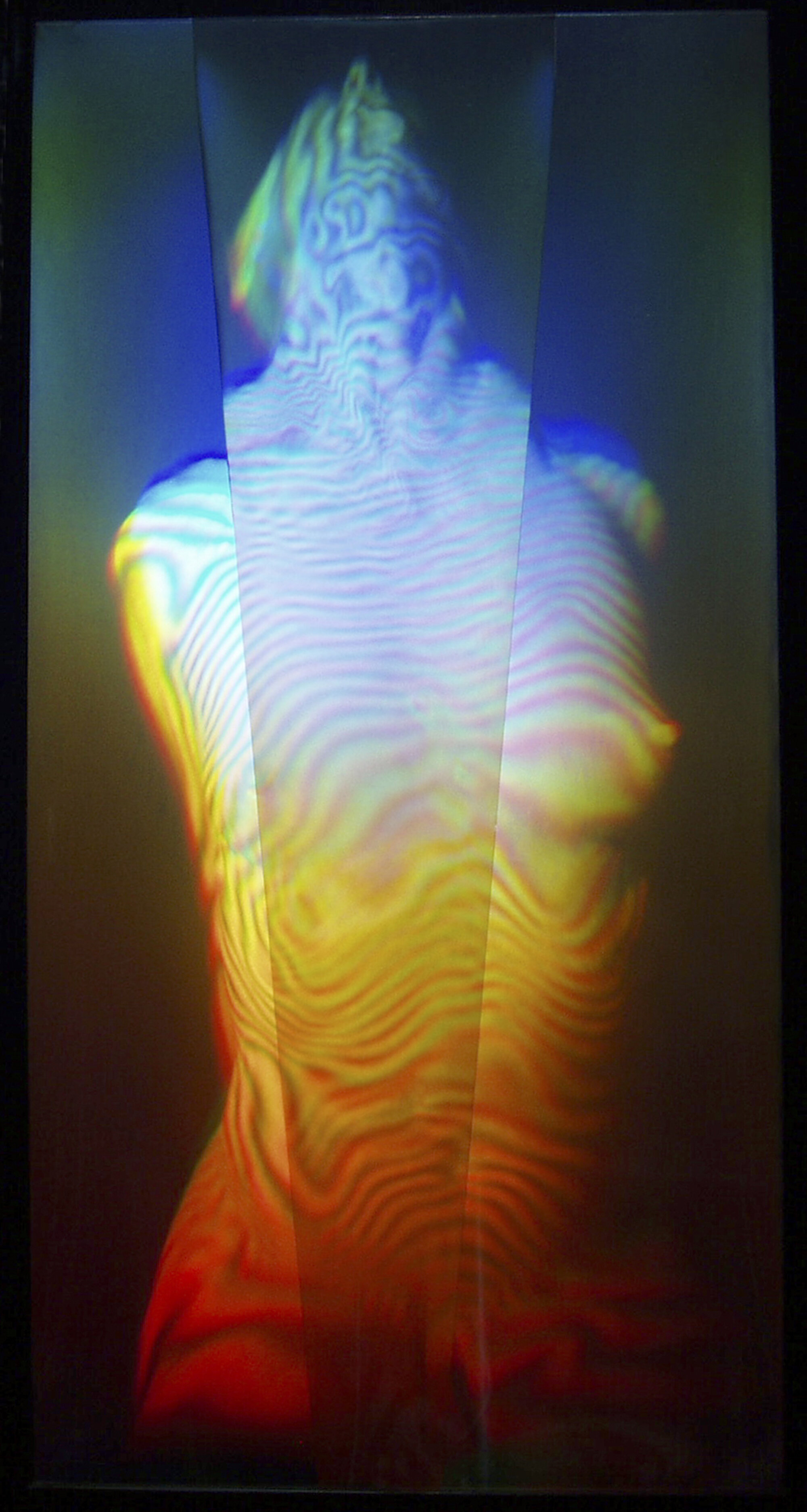Holography
In the early 1980's while attending MIT in Cambridge, Massachusetts, Weber became fascinated with the dimensional quality of laser light. "It seemed to hang in space sparkling in the truest red I'd ever seen," said Weber. "I wanted to work with light, its effect on architectural space, and the internal resonance we feel for color as the essential nature of light itself." (This Side Up magazine, Netherlands, 10/2/2000)
Descent (2006)
Six images, film on glass, LED illuminators.
Holograms titled: Terrain, Laccolith, Crevasse, Fissure, Pinnacle, and Fossil.
Laser exposures with human subjects were made a micro-second apart to capture the internal movements of breath, blood, and muscle tension.
The patterns of light and dark across the figures portray the micro movements of breath, blood, and muscle tension captured by laser light. Normally unseen, these layers of constant motion reveal the turbulence of forces that lie beneath, hidden like geological strata.
- Sally Weber, “in FLUX” (catalog), September 29- October 21, 2017, Johnson City, TX
Threshold of a Singularity - A Memorial (1989)
Two holographic panels, 84’x 42’. Holographic screen with glass chemistry vessel, metal pan and water, 32”x45.” Limited edition
This installation seeks to capture the edge of a black hole: the event horizon that defines the end point of matter, light, and life as we know it. Beyond the edge lies theory, imagination, and beliefs. This work is a memorial to the artist’s father.
VIDEO: Sally Weber, Threshold of a Singularity - A Memorial (1989).
Alignment (1987)
Holographic optical element, cast acrylic, 7’x 3’x 20”.
Three focused lines of light create a physical, spatial presence six feet in front of the sculpture. Moving into it, the lines fuse and sweep across the sculpture’s concave surface immersing the viewer in the projected color field of the work.
In the collection of the Osthaus Museum, Hagen, Germany.
The American sculptress Sally Weber’s “Alignment” creates three lines of red, green, blue (the additive primaries of light), which appear to hover six to eight feet in front of a curved acrylic screen, merge to make other colours, and finally white light, according to the position of the viewer. The work exemplifies what Weber has called “the natural integration of time, space and light,” which differs only in its advanced technology from the light cultures in many ancient civilizations, from Egypt to the Americas. Here, the “accidental” colours at last harness their mystery for aesthetic ends.
- John Gage, Color in Art, Thames and Hudson, world of art, New York, NY, 2006
The artist measures laser light exposure during holography shoot for Alignment, Advanced Dimensional Displays, Van Nuys, CA, 1986.
Focalpoint (1982)
Wood, steel, glass pipes, holographic optical elements, and water. 10’x 4’x 8’.
Holographic lenses diffract and focus sunlight into spectral lines that track the sun’s motion across the floor. The entire work is seen in a single color of light from its focal point, ten feet from the sculpture. Weber's research into archeoastronomy, a method for orienting structures to monitor stellar and solar motion, sparked her interest in bringing the natural transition of time into the built environment with light.
Lightscape (1982)
Acrylic and holographic optical elements. Dimensions variable.
The curved elements in this experimental work were inspired by sun’s path across the sky. Sunlight diffracts the holographic elements into spectral colors that alter with the viewer’s position or lighting conditions.
“Lightscape” reflected an ability to create a focal point affecting an entire site. Sally’s use of holographic diffraction gratings became a means through which she can further explore the potential use of directionally controlled light on an architectural scale . . . an important, very promising inquiry into an unexplored field of “enlightened” architecture.
— Otto Piene, Director of the Center for Advanced Visual Studies, MIT, letter, July 7, 1982
MIT Tech Talk, May 26, 1982

















